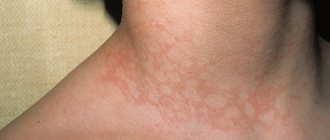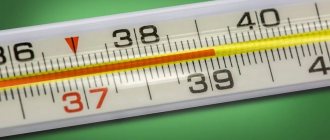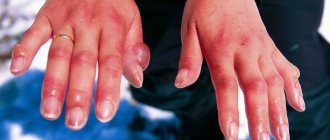The norm is considered to be a general body temperature of +36 to +37°C. A periodic decrease to +35.5°C is possible with hypotension, hypothermia and some infections. Usually this condition normalizes on its own over time. But there are situations where hypothermia is very dangerous.
Nervous and physical exhaustion
High physical activity, prolonged stress, lack of sleep, poor diet and strict diets often lead to a deficiency of the body’s energy resources. As a result: metabolism slows down, blood circulation slows down and the temperature drops below normal by 1-2 degrees. The pathological condition is accompanied by significant weight loss, apathy, weakness, fatigue, depressed mood or increased nervous excitability. There may be frequent headaches and decreased mental abilities. The person becomes distracted and inhibited. There is a weakened immune system and hypovitaminosis.
With physical and nervous exhaustion, body temperature steadily decreases to +35–35.5°C. The condition is accompanied by chills even in warm weather. This pathology is usually not life-threatening, but it is an alarming sign that requires urgent lifestyle changes.
Internal hemorrhage
Internal bleeding may be caused by damage to blood vessels. In turn, it can be caused by the progression of peptic ulcer disease, tumor growth, disturbances in the functioning of the cardiovascular system, and increased fragility of the vascular walls.
Also, internal bleeding can be caused by problems in the endocrine system and diseases associated with metabolism.
The chronic form of internal hemorrhage can occur without significant symptoms.
A feeling of fatigue, characteristic diseases that may be indicated by the patient's medical history, pale skin and drowsiness may be signs of hemorrhage. In case of injury or bruises of internal organs, hypothermia indicates the need for specialist help. If the patient loses consciousness, you should not hesitate under any circumstances; urgent hospitalization is necessary.
Post-viral syndrome
In this case, the body temperature usually stays around +35.5°C or +35°C for several days. In the fight against infections, the body spends a lot of internal resources, suffers from the consequences of intoxication and microbial aggression, which is why many functions, including thermoregulation, are disrupted. The early period of recovery is often accompanied by a decrease in temperature. The condition is accompanied by other symptoms: physical weakness, bad mood, drowsiness, decreased concentration. Shortness of breath may occur, worsening with exertion and stress. Children, adolescents, and people with chronic vascular and central nervous system diseases are susceptible to pathology.
If the thermometer is above 36.6 degrees C
Situations with low temperatures in clinical practice are much less common than indicators above 36.6 degrees C. Many modern people have come to regard moderately elevated indicators (low-grade fever) as a necessary condition for the body’s fight against infection. That is, if the temperature does not exceed 380, today there is no rush to bring it down, realizing that as the degrees rise, the body’s protective functions improve.
Still, you should not sit idly by at elevated (above 37.1) temperatures. This is a signal about a developing inflammatory process, which means that the body needs to help cope with it:
- if there are obvious signs of a cold, provide plenty of warm drinks, rinse the throat and nose with a saline solution, and ventilate the patient’s room;
- if you have acute pain (head, stomach, ears), consult a doctor;
- If there are signs of intoxication (nausea, vomiting, diarrhea), call an ambulance.
In a situation where the temperature remains at a low-grade level for weeks or months, it is also necessary to see a doctor and undergo an examination, since tuberculosis, endocrine or tumor diseases may be hidden behind this symptom.
If the temperature is above 36.6 degrees, but does not exceed 37.10 C, there is no reason to worry.
Low blood glucose
Hypoglycemia due to prolonged hunger and excess insulin provokes energy starvation of the brain, slows blood circulation and metabolism. As a result of glucose deficiency, physical weakness develops, dizziness, and attacks of hunger. With a prolonged lack of sugar in the blood, coordination of movements is impaired, asthenia sets in, the body breaks out in cold sweat, and body temperature drops to +35°C. In the absence of outside help to the body, fainting and hypoglycemic coma are possible. People of any age are susceptible to pathology; insulin-dependent patients suffer more often than others.
Normal body temperature in adults
The normal human body temperature is considered to be 36.6 0 C. But research in the field of medicine shows that each person can have his own normal value. An individual body temperature indicator in men is formed before the age of 20, and in women - up to 14.
It may depend on various factors:
- floor;
- age;
- race;
- human activity.
As an example, the table below shows normal temperature indicators for people at different ages.
| Age | Indicator (in °C) |
| Newborns | 36,8 |
| Six-month-old children | 36,6 – 37 |
| One year old children | 36,6 – 37 |
| Children aged 6 years | 36,5 — 37 |
| Adults (reproductive age) | 36,4-36,9 |
| Aged people | 36,3 |
The temperature can vary during the day from 35.5 to 37.2 °C. Thus, the highest temperature is recorded in the evening, and the lowest in the morning. The location of temperature measurement also plays an important role - when measured in the ear or rectally, the norm will be 37.5 °C, and in the mouth - 36.8 °C.
Body temperature 36 in an adult (the cause is determined after examination) in the presence of the disease is accompanied by certain symptoms:
- General weakness, lethargy.
- Decreased activity.
- The skin becomes pale.
- Trembling sensation.
- Hands and feet become cold.
- Rarely, loss of consciousness, blurred vision, slurred speech, and even hallucinations may occur (such symptoms most often occur at temperatures below 34 ° C).
Help with hypothermia
Immediate measures: exposure to heat, elimination of hunger, neutralization of toxins. A person with hypothermia is advised to drink hot tea, take a bath, and wrap himself in a thick blanket. In critical conditions, hospitalization is required.
The exact causes of the pathological symptom are determined by the therapist or doctors of other profiles. Diagnostics includes biochemical and hormonal blood tests, ECG, ultrasound of internal organs, computed tomography or MRI of the spine and brain. A complete medical examination helps to identify the most unexpected causes of low temperature.
Drug therapy depends on the established diagnosis. These can be antibiotics, immunomodulators, antidepressants, nootropics. To consolidate the results of treatment, the doctor usually recommends purchasing vitamin and mineral complexes.
Treatment
Help before diagnosis
If the body temperature is more than 32°, you can get by with passive warming. The person is wrapped in heated blankets or placed in a bath with warm water and given hot tea. With prolonged hypothermia and satisfactory condition during the convalescence period, specific treatment is not required - sleep 8-10 hours a day, increased calorie intake, and adequate rest are recommended. If the reasons for the detected low temperature are unclear, consult a doctor.
First aid for hypothermia
Conservative therapy
At critically low temperatures, active warming is effective: heat fans and heating pads, inhalation of warm humidified oxygen and intravenous infusion of heated solutions. In emergency situations, warm lavage and extracorporeal blood purification methods are used. For etiotropic and pathogenetic treatment of diseases accompanied by a drop in human body temperature below 36 degrees, the following are prescribed:
- Vitamins
. With general exhaustion of the body, B vitamins are indicated, which enhance neuromuscular transmission and improve the trophism of nervous tissue. Alpha tocopherol is used as a powerful antioxidant. For severe weakness, glucose solutions with vitamin C are administered. - Hormones
. Replacement therapy with levothyroxine allows you to accelerate the processes of metabolism and thermogenesis, and restore normal body temperature. In case of Addison's disease, cortisol preparations are necessary; in case of a lack of mineralocorticoids, aldosterone is additionally administered. - Cardiotropic drugs
. Medicines stimulate cardiac activity in shock and other critical conditions, normalize cardiac output and increase blood pressure. The drugs of choice for emergency care are solutions of adrenaline or dobutamine; in hospital therapy is supplemented with glycosides. - Antidepressants
. The medications are serotonin receptor agonists and improve neural connections between different parts of the brain. Temperature normalization occurs due to stimulation of the hypothalamic center and increased contractile thermogenesis. - Antibiotics
. Hypothermia often masks the manifestations of a severe bacterial infection, so broad-spectrum antibiotics are indicated for very low body temperatures. Medicines are administered intravenously until temperature values normalize and general condition improves. - Antidotes
. For acute signs of intoxication, universal drugs are used that bind or destroy various toxic substances. In cases of heavy metal poisoning and drug overdose, unithiol is effective.
When is a low temperature considered normal?
A low temperature is considered normal in a number of cases:
- the person has no other symptoms (as described above);
- old age (but not lower than 36 °C and in the absence of unpleasant symptoms);
- in women during the menstrual cycle;
- when using hormonal medications.
There are often cases when the temperature changes depending on the season, or rather the time of year. Also, the temperature indicator can fluctuate by 0.5-1°C for the same person in different climatic zones.
Therefore, it is important to monitor the accompanying symptoms - if nothing bothers you and the person feels great, then there is no reason to worry (provided that the temperature does not fall below 35.5 ° C).
Differential diagnosis
A body temperature of 36 in an adult (the cause may be related to the presence of serious diseases) often indicates possible pathologies in the body. Therefore, it is recommended to carry out differential diagnosis. This method allows you to establish an accurate diagnosis based on a set of other symptoms.
Diagnostics is carried out in 3 stages:
- First, the patient’s medical history is carefully studied and the reasons for the appearance of low temperature (for example, hypothermia) are determined.
- At the 2nd stage, a direct examination of the patient is carried out, and concomitant symptoms are also studied in detail.
- The final step is to conduct laboratory and other tests to confirm a particular diagnosis.









